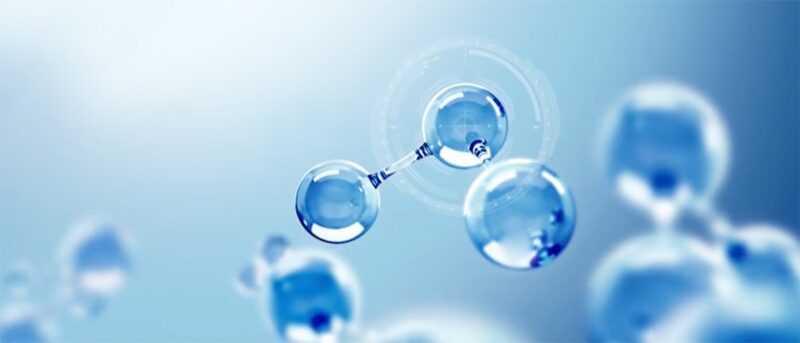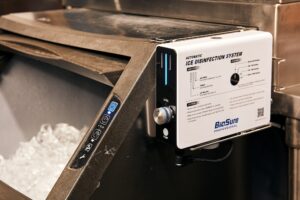We’ve all heard of Ozone. It’s a gas that occurs naturally in trace amounts in the upper atmosphere that can protect the Earth from the Sun’s harmful radiation. But did you know that ozone is also extremely useful in our food and beverage industry?
Ozone water, also known as ozonated water or aqueous ozone is one of the strongest disinfectants known to mankind. It is effective and fast in disinfection. Compared to general chlorine disinfectants, its disinfection speed is said to be 3,000 times faster, and its sterilization ability 50 times stronger.
An Environmental-Friendly Disinfectant
Ozone water is also one of the safest disinfectants. It’s 100 percent natural. In fact, the ozone cycle is happening every day around us. Ozone in the air protects us from the harm of UV and microorganisms. The energy from lightning and ultraviolet light break down oxygen molecules to form ozone. These reaction processes can absorb harmful ultraviolet rays and convert them into heat energy, while also effectively purifying the air. After the ozone decomposes those organic matters, it will revert to oxygen. The whole process does not produce any harmful substances.
The ozone water that is produced by BES electrolytic ozone generator leaves no chemical residues, nor has a taste or smell after the reaction. It is widely used in the food and beverage industry because it does not change the taste of food when applied for food sanitation. It also has no effect on the pH balance of water. And rest assured, it causes no negative effect or irritation to our mouth, nose, or skin. T. This advanced ozone technology produces no NOx, which is known as a carcinogen, without raising a health concern and the producing process creates no known carcinogens, allowing it to be discharged directly without causing environmental pollution
Because of its safe and reliable characteristics, as early as 2001, the US FDA has approved ozone water as a safe disinfectant and added protection for food ingredients and food-contacting surfaces.
How We Benefit From Ozone
Ozone Disinfection is a “broad-spectrum” disinfection. Ozone water can directly oxidize and decompose essential biomolecular components in bacteria. Therefore, bacteria cannot survive in ozone water. Also, unlike chemical fungicides, pathogenic bacteria cannot develop a resistance to high-concentration ozone water.
Ozone Water, or Ozonated Applications
The treatment of water with ozone has a wide range of applications. It’s efficient for disinfection as well as for the degradation of pesticides in industries including food and beverage, bottling, healthcare, commercial laundry, and wastewater treatment, just to name a few. Electrolytic ozone is one of the most effective methods to produce ozone. It’s done by subjecting oxygen (O2) to a high electric voltage. Below are some of the main applications for ozonated water.
- Disinfection
Ozonated water is becoming a more cost-effective, safer, and more efficient replacement for chlorine in the food and beverage, and hospitality industries. Kitchen managers are integrating ozonated water as a surface disinfectant, automating sanitation by implementing ozone systems in beverage lines and eliminating bacteria in the commercial laundry. The benefits over chlorine include cost savings over the long term, no chemical residues, and ozone systems that automate the disinfection process, removing the possibility of human error. - Infection Control
Ozone is one of the most powerful and effective disinfectants on the market. This means ozonated water is great at disinfecting dental unit waterlines that tend to collect biofilm and bacteria due to their narrow tubing and inconsistent water flow. Through ozonated water in dental water units, patients have been kept safe from numerous diseases caused by contaminated water lines in the past, making ozone a primary ally against infection.
- Food Preparation
When ozone is placed into water, it’s able to kill viruses, bacteria, and reduce pesticides that are situated in the substance. Restaurant and central kitchen staff count on ozonated water to disinfect vegetables and fruits, getting rid of any contaminants on the surface. Washing fish and meat in ozonated water will get rid of any parasites and bacteria while also increasing the shelf life for the product. - Beverage Bottling
Ozone is widely used in bottling plants of major beverage corporations. Ozonated water is simply sprayed into each bottle to disinfect the plastic or glass bottles before mineral water, soda, or other common beverages are put inside. If you’ve ever drink soda or bottled water, then we can say that ozone is not far away from us. - Other Applications
Hotels, restaurants, catering businesses, bars, and breweries have equipped ozone water disinfection systems for beverage line disinfection, hand washing, food materials disinfection, food processing station cleaning, and tool disinfection. These are just a few applications where chlorine has traditionally been used. However, chlorine’s numerous disadvantages have led to ozone being the new sustainable standard of disinfection.
How Ozone Is Created
Ozone cannot be stored because of the short half-life and must be produced on-site and on-demand. Therefore, an ozone generator is the most critical component of any successful ozone system.
There are three common methods to generate ozone: corona discharge (CD ozone), photochemical (UV ozone), and electrochemical (electrolytic ozone). The photochemical method is the most economical method, yet the ozone it produces has lower purity, with a concentration of only about 0.3% or lower, and its productivity is the lowest among all three methods.
The electrolytic method is by far the safest way to produce ozone with higher purity. In this process, water is introduced to the anode side of the electrolysis cell, electrolytically decomposed, and converted to ozone. Through this method, In addition to gaining ozone in high concentration, the amount of gas aeration is also small and the efficiency of dissolution is also high, achieving the advantages of safety and low cost of post-processing.
BioSure – Leading in Ozone Disinfection
Since 1988, BES Group has been a leading electrolytic ozone manufacturer dedicated to “chemical-free” sanitation solutions. BioSure Professional, under BES Group, provides professional solutions applying advanced ozone technologies in food safety and hygiene, commercial laundry, air quality control, water treatment, healthcare, and other industries.
Our sanitation solutions have helped numerous global corporations and organizations, spanning hospitality to medical care industries, to reduce millions of chemical detergents use annually. The Central Ozone Water Disinfection System we offer uses BES patented electrolytic ozone technology, generating ozone-dissolved water containing high concentration ozone. It can be integrated with the existing water supply, transforming the general tap water into high-concentration antibacterial disinfection water. It’s just that simple and hassle-free.
Copyright besgroups.com All Rights Reserved
Related Articles
How Ozonated Water Works
Your Questions on Ozone Water Answered
What is the Advantage of Electrolytic Ozone?
Ozone Spray vs 75% Alcohol for Sanitizing
Is Ozone Water Safe?



